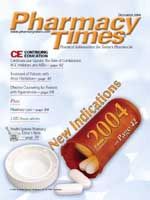Publication
Article
Pharmacy Times
GERD Patients Have Esophageal Pain Hypersensitivity
Although crushing chest pain most often is indicative ofmyocardial ischemia, ischemic heart disease is excluded inone third of patients with angina-like chest pain. Many ofthese patients (up to 60%) have gastroesophageal reflux disease(GERD). The role of acid reflux in causing this chest painis unknown, as is the effect of gastric acid suppression onsymptoms.
In a study published in the October 2004 issue of The AmericanJournal of Gastroenterology, Sanchoy Sarkar, PhD, MRCP,BSc, and colleagues examined the contribution of acid refluxto esophageal pain hypersensitivity in patients with GERDand unexplained chest pain (n = 14) and in healthy volunteers(n = 8). Results showed that patients with GERD have alower resting upper esophageal pain threshold (PT; measuredby electric stimulation), compared with controls (40.8 + 9 mAvs 70.4 + 11 mA; P = .03).
Acid infusion reduced PTs in controls but not in patients.Six patients underwent a repeat study after 6 weeks of protonpump inhibitor (PPI) therapy. Among those patients, restingPT increased (34.65 + 13.4 mA to 40.5 + 12.5 mA; P = .03), andacid infusion resulted in PT reductions. The authors concludedthat patients with GERD and unexplained chest pain haveesophageal pain hypersensitivity, which may be the result ofcentral sensitization that is responsive to PPI treatment.







